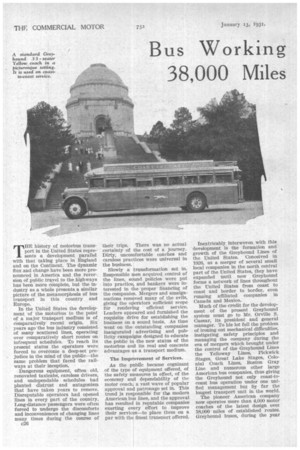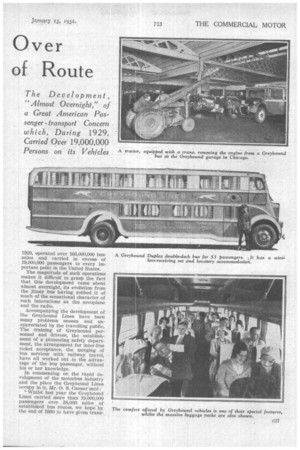Bus Working Over 38,000 Miles of Route
Page 48

Page 49

Page 50

If you've noticed an error in this article please click here to report it so we can fix it.
THE history of motorbus transport in the United States represents a development parallel with that taking place in England and on the Continent. The dynamic flux and change have been more pronounced in America and. the raver-, sion of public travel to the highways has been more complete, but the industry as a whole presents a similar picture of the metamorphosis of bus transport in this country and Europe.
In the United States the development of the motorbus to the point of a major transport medium is of cOmparatively recent origin. Six years aguthe bus industry consisted of many scattered lines, operating over comparatively short routes on infrequent schedules. To reach its present status the operators were forced to overcome a deep-set prejudice in the mind of the public—the Same problem that faced the railways at their inception.
Dangerous equipment, often old, renovated taxicabs, careless drivers, and undependable schedules had planted distrust and antagonism that have taken years to remove. Disreputable operators had opened lines in every part of the country. Long-distance passengers were often forced to undergo the discomforts and inconveniences of changing linen many times during the course oE
c26 their trips. There was no actual certainty of the cost of a journey. Dirty, uncomfortable coaches and careless practices were universal in the business.
Slowly a transformation set in. Responsible men acquired control of the lines, sound policies were put into practice, and bankers were interested in the proper financing of the companies. Mergers and amalgamations removed many of the evils, giving the operators sufficient scope for rendering efficient service. Leaders appeared and furnished the requisite drive for establishing the business on a sound basis. As time went on the outstanding companies inaugurated advertising and publicity campaigns designed to educate the public in the new status of the motorbus and its real and concrete advantages as a transport medium.
The Improvement of Services.
As the public became cognizant of the type of equipment offered, of the safety measures in effect, of the economy and dependability of the motor coach, a vast wave of popular approval and patronage set in. This trend is responsible for the modern American bus lines, and the approval has resulted in reputable companies exerting every effort to improve their services—to place them on a par with the finest transport offered. Inextricably interwoven with this development is the formation and growth of the Greyhound Lines of the United States. Conceived in 1926, as a merger of several small local companies in the north central part of the United States, they have expanded Until now Greyhound forms a network of lines throughout the United States from coast to coast and border to border, even running affiliated companies in Canada and Mexico.
Much of the credit for the development of the present Greyhound system must go to Mr. Orville S. Caesar, its president and general manager. To his lot fell the problem of ironing out mechanical difficulties, instigating safety principles and managing the company during the era of mergers which brought under the control of the Greyhound Lines the Yelloway Lines, Pickwick Stages, Great Lake Stages, Colonial Coach Lines, Boston Gray Line and numerous other large American bus companies, thus giving the Greyhound not only coast-tocoast bus operation under one unified management but by far the longest transport unit in the world.
The pioneer American company now operates more than 4,000 motor coaches of the latest design over 38,000 miles of established routes. Greyhound buses, during the year 1929, operated over 105,000,000 busmiles and carried in excess of 19,000,000 passengers to every important point in the United States. The magnitude of such operations makes it difficult to grasp the fact that this development came about almost overnight, its evolution from the jitney bus having robbed it of much of the sensational character of such innovations as the aeroplane and the radio.
Accompanying the development of the Greyhound Lines have been many problems unseen and unappreciated by the travelling public. The training of Greyhound personnel and drivers, the establishment of a pioneering Safety d6partmeat, the arrangement for inter-line ticket acceptance, the merging of bus services with railway travel, have all worked out to the advantage of the bus passenger, without his or her knowledge.
In commenting on the rapid development of the motorbus industry and the place the Greyhound Lines occupy in it, Mr. 0. S. Caesar said : "Whilst last year the Greyhound Lines carried more than 19,000,000 Passengers over 38,000 miles of established bus routes, we hope. by the end of 1930 to have given trans
port to more than 25,000,000 people. Our plans for this year call for /50,000,000 miles of bus transport.
"The development of more luxurious buses will bring about a greatly accelerated acceptance of coach travel.
"The two factors of economy and convenience afford the motorbus a prominent place in the whole scheme of passenger travel. Those now engaged in bus operation in this country universally foresee still more rapid and outstanding development.
"In counteracting seasonal slumps in business the Greyhound Lines have developed a type of special business calculated to keep surplus equipment in service. In building up this type of service the Greyhound Lines have attracted charter patronage of numerous and diversified types. Special advertising and publicity campaigns have been inaugurated with the intention of stimulating group travel.
"A recent outstanding example of Greyhound booked-coach business was the tour made through the southern part of the United States by delegates to the sixth International Road Congress. Eightyeight delegates from 35 foreign nations, including several from Eng
land, and representatives of the United States Department of Commerce, United States Bureau of Public Roads, and representatives of the National Automobile Chamber of Commerce, lefeWashington, the capital of the United States, on a 2,000-mile highway-inspection tour of the United States, travelling in a fleet of six Greyhound motor coaches. On their return to their port of departure the delegates unanimously expressed themselves as being amazed and delighted at the Greyhound Lines' service and at the tremendous strides that have been made in American bus transport."












































































































